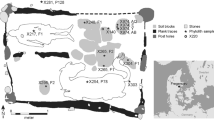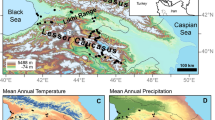Abstract
A total of 20 samples from sites LU-69 and PU-165 were processed, identified, and counted at the University of Exeter Archaeobotany Laboratory. Phytolith extractions from the archaeological sediments followed standard procedures. Samples were deflocculated in a shaker with Calgon for 24 h. Clays were washed by gravitational sedimentation, carbonates were removed using hydrochloric acid, and organic matter was removed with nitric acid and potassium chlorate when necessary. Samples were floated in a zinc bromide solution at a specific density of 2.3 g/ml, dried in acetone, and mounted in Permount. In order to maximize the recovery of important phytoliths of different size classes, such as those that derive from the rinds of Cucurbita fruits and leaves and cobs of maize, archaeological sediments were separated by wet sieving into silt (2–50 µm) and sand (50–2,000 µm) fractions. The entire extract recovered from the sand fraction was scanned in search for Cucurbita phytoliths and other large arboreal and economic plant forms. Extended counts of the silt fraction were carried out in order to obtain a large sample of cross-shaped phytoliths in order to detect the presence of maize leaf phytoliths. Only sample No. 28 from PU-165 did not contain crosses, which prevented carrying out the discriminant function to test the presence of a maize leaf phytolith.
Access this chapter
Tax calculation will be finalised at checkout
Purchases are for personal use only
Similar content being viewed by others
References
Bertoli de Pomar, H. (1971). Ensayo de clasificacion morfologica de los silicofitolitos. Ameghiniana, 3–4, 317–328.
Brown, D. A. (1984). Prospects and limits of a phytolith key for grasses in the Central United States. Journal of Archaeological Science, 11, 345–368.
De Campos, A. C., & Labouriau, L. G. (1969). Corpos siliceos de gramineas dos Cerrados- II. Pesquisas Agropecuarias Brasileiras, 4, 143–151.
Fredlund, G. G., & Tieszen, L. T. (1994). Modern phytolith assemblages from the NorthAmerican Great Plains. Journal of Biogeography, 21, 321–335.
Iriarte, J. (2003). Assessing the feasibility of identifying maize through the analysis of cross-shape size and tridimensional morphology of phytoliths in the grasslands of Southeastern South America. Journal of Archaeological Science, 30, 1085–1094.
Mulholland, S. C. (1989). Phytolith shape and frequencies in North Dakota grasses: A comparison of general patterns. Journal of Archaeological Science, 16, 489–511.
Pearsall, D. M. (2000). Paleoethnobotany. A handbook of procedures. San Diego: Academic.
Piperno, D. R. (2006). Phytolith. A comprehensive guide for archaeologists and paleoecologists. San Diego: Altamira.
Piperno, D. R., & Pearsall, D. M. (1998). The silica bodies of tropical American grasses: Morphology, taxonomy, and implications for grass systematics and fossil phytolith identification. Smithsonian Contributions to Botany 85. Washington, DC: Smithsonian Institution Press.
Sendulsky, T., & Labouriau, L. G. 1966. Corpos siliceos de Gramineas dos Cerrados-I. Annais da Academia Brasileira de Ciencias, 38, 159–185.
Sondahl, M. R., & Labouriau, L. G. 1970. Corpos silicosos de gramineas dos Cerrados-IV. Pesquisas Agropecuarias Brasileiras, 5, 183–207.
Teixeira da Silva, S., Labouriau, L. G. (1970). Corpos siliceos de gramineas dos Cerrados- III. Pesquisas Agropecuarias Brasileiras, 5, 167–182.
Twiss, P. C. (1992). Predicted world distribution of C3 and C4 grass phytoliths. In G. Rapp, S. C. Mulholland (Eds.), Phytolith Systematics. Emerging Issues (pp. 113–128). New York: Plenum.
Twiss, P. C., Suess, E., Smith R. M. (1969). Morphological classification of grass phytoliths. Proceedings of Soil Science of America, 33, 109–115.
Zucol, A. F. (1996). Microfitolitos de las Poaceae Argentinas: I. Microfitolitos foliares de algunas especies del genero Stipa (Stipae:Arundinoideae), de la Provincia de Entre Rios. Darwiniana, 34, 151–172.
Zucol, A. F. (1998). Microfitolitos de las Poaceae Argentinas: II. Microfitolitos foliares de algunas especies del genero Panicum (Poaceae, Paniceae) de la Provincia de Entre Rios. Darwiniana, 36, 29–50.
Zucol, A. F. (1999). Fitolitos de las Poaceae argentinas: IV. Asociacion fitolitica de Cortadeira selloana (Danthonieae: Poaceae), de la Provincia de Entre Rios (Argentina). Natura Neotropicalis, 30, 25–33.
Zucol, A. F. (2000). Fitolitos de Poaceae de Argentina. III. Fitolitos foliares de especies del genero Paspalum (Paniceae) en la Provincia de Entre Rios. Darwiniana, 38, 11–32.
Author information
Authors and Affiliations
Rights and permissions
Copyright information
© 2014 Springer International Publishing Switzerland
About this chapter
Cite this chapter
Iriarte, J. (2014). Appendix 4: Phytolith Analysis of Sites LU-69 and PU-165. In: The Teleoscopic Polity. Contributions To Global Historical Archaeology, vol 38. Springer, Cham. https://doi.org/10.1007/978-3-319-03128-6_15
Download citation
DOI: https://doi.org/10.1007/978-3-319-03128-6_15
Published:
Publisher Name: Springer, Cham
Print ISBN: 978-3-319-03127-9
Online ISBN: 978-3-319-03128-6
eBook Packages: Humanities, Social Sciences and LawSocial Sciences (R0)




